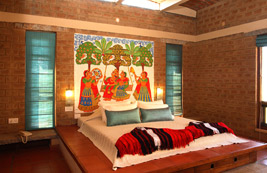Phad Folk Arts
Monday 7 November 2011
Par Phad Mural
Even at a distance, the Par (also Phad) is unmistakable. Its immodest hues of yellow, red, orange, grey and green – harmoniously blend to create a regal masterpiece. The Pars are often dedicated to the valiant exploits of folk hero-gods - Pabuji or Devnarayan. Mythological deities and riders on caparisoned horses and elephants share the space with birds, animals, trees and flowers; articulating the splendour of the times their stories were set in.
The Par, is a painting on a long rectangular cloth scroll used as a visual aid by bards (“bhopas”). A bhopa commissions the Par when a villager requests for a performance of an epic. This is often in gratitude to a deity for a prayer answered. At night, in the flicker of the oil lamp, the Par comes to life as the bhopa sings the story in warm, raspy tones.
The painting of a Par was a religious procedure. An auspicious date was chosen to begin painting and an offering made to Sarasvati, goddess of learning and the arts. A virgin girl from the artist’s family or that of a high caste family would make the first brush stroke. Colors are then painted one at a time. That is, the artist will paint all the areas that require orange first, then yellow, and so forth. Finally, the artist completes the picture by outlining the images in black. A ceremonial Par may measure up to 35 ft in length.
Par painters were always men belonging to the Chhippa caste from Bhilwara and Chittor districts. The skill of painting Pars, typically handed down from father to son was a closely guarded secret. These paintings have a long history with the earliest known Par’s dating back to the early 19th century.
Subscribe to:
Posts (Atom)



